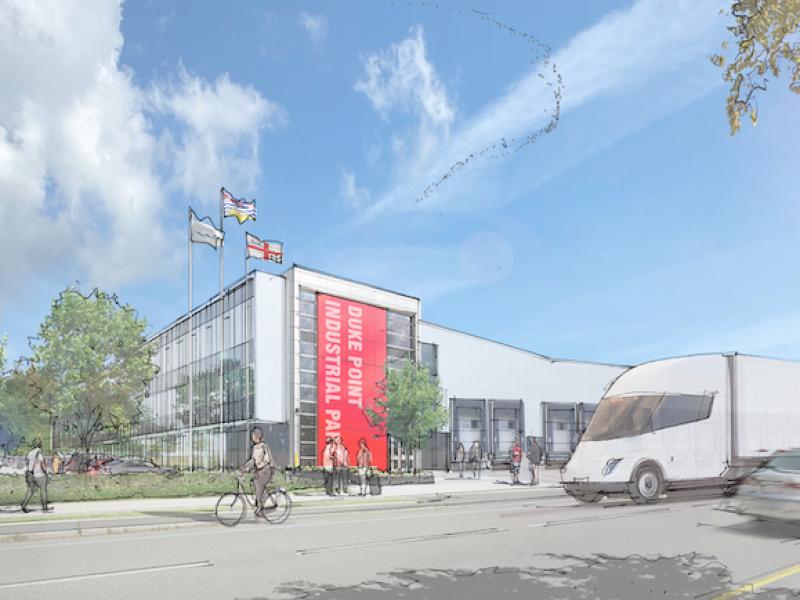Seacliff Properties is gearing up to launch a 726-acre master-planned community that could eventually add 2,200 homes and more than three million square feet of industrial space to the southern edge of Nanaimo near the Trans-Canada Highway.
The Sandstone master plan was adopted in 2021 as part of the city’s official community plan and has taken a major step forward in the rezoning process, said Georgia Desjardins, director of development at Vancouver-based Seacliff Properties.
“The zoning bylaw did go for a public hearing and successfully passed a third reading on Nov. 16,” Desjardins told RENX in an interview.
Desjardins said her team is looking forward to the next required approval from the city, but is waiting for the local government to review the B.C. government’s recently proposed legislation that would require municipalities to permit three to six units on most single-family lots in communities over 5,000 residents (depending on the size of the lot).
“They’ll need to await further clarification around the implications of those newly announced regulations before the bylaw can be moved for consideration of final adoption by city council,” Desjardins said.
Full build-out could take 20 years
The Sandstone master plan could take up to 20 years to fully build out.
Desjardins said the project is to include 2,200 homes of various types, including single-family homes, attached homes and multifamily buildings.
It will also include up to 125,000 square feet of commercial space and potentially three million square feet of industrial space.
Sandstone will also include 200 acres of new park space and green areas, as well as investments into local transportation and infrastructure networks.
Once approvals are secured, the first steps will include land-work to prepare for the delivery of residential and industrial space, Desjardins said. Infrastructure preparation work would also begin.
Desjardins said Seacliff, which is also developing a master-planned, mixed-use community in Colwood near Victoria, is developing Sandstone on its own.
“A major focus of Sandstone is to provide new economic and business opportunities (by) providing extensive industrial growth along with commercial space,” Desjardins said.
Nanaimo’s growth as transport, distribution hub
“Located at the junction of the Trans-Canada Highway and Duke Point Highway, the site has convenient access via land and sea, and will further grow and support the city as a key transportation and distribution hub on Vancouver Island,” Desjardins said.
Investment in infrastructure, such as the proposed expansion of Port of Nanaimo’s Duke Point terminal, strengthens the potential for significant business and employment growth opportunities, Desjardins said.
The decision to choose such a massive scale of development stems from the city’s community plan, which sets out how the city envisions growth and its long-term needs, Desjardins said.
The community is also experiencing a housing crisis and more diverse types of homes are needed, she said.
Desjardins said a land inventory study for the City of Nanaimo produced by Colliers in 2020 confirmed there is a shortage of industrial land that would be exacerbated by future projected growth if more supply is not added to the market.
“The zoning permits both industrial and light industrial opportunities,” Desjardins said. “So we really see it as a combination of . . . a range of smaller-bay and larger-scale industrial uses.”
As the neighbourhood takes shape over 20 years, the needs and wants of companies and residents will help to drive the development process and choices.
Seacliff anticipates a combination of assets for sale and for lease at Sandstone.
The City of Nanaimo’s population for 2022 was projected to be 102,531 and the Regional District of Nanaimo at 175,999, according to the city’s 2023 State of the Nanaimo Economy report.
Nanaimo’s population growth rate over the last census was 10.3 per cent, significantly higher than B.C. at 7.6 per cent and Canada at 5.2 per cent, the report said.
Seacliff has long-term confidence in the Nanaimo area and central Vancouver Island that it feels is well-serviced by ferries, land and air, Desjardins said.
Developer taking next steps on Victoria-area community

Seacliff, which is also active in Vernon and Sechelt, is also focused on a master-planned community in the B.C. capital region.
In 2022, Seacliff Properties and Reliance Properties launched a joint venture to build a $1.2-billion, master-planned seaside community over a 15-year period in Colwood.
Initially called Royal Beach, the project has been renamed The Beachlands, Desjardins told RENX.
“We’ve continued to work hard to progress our applications, so we currently have two different subdivision applications in and we have two different development permit applications in.”
The two building permit applications, if approved, would launch the initial phase of construction before the end of this year.
Beachlands will be a collection of neighbourhoods totalling 2,850 homes (single-family houses, townhomes and apartments), plus hundreds of job spaces in commercial buildings and retail spaces.
The site is 135 acres of oceanfront land with 1.4 kilometres of shoreline. More than 47 acres of the site will be dedicated to public parks and greenspace.
The first two phases will include a 12,000-square-foot commercial building hosting the site’s Discovery Centre and a food and beverage retailer.
The first housing offering will include 180 units in a combo of townhomes and multifamily buildings up to six storeys.
Asked about possible shifts in the company’s development plans due to current economic and financing challenges in the market, Desjardins said master-plan communities typically develop throughout various economic cycles and require a long-term commitment and vision.
“We certainly take a longer-term view than a one-off, standalone project would otherwise be able to take,” she said.
“There’s a lot of challenging economic factors that are influencing the market today, but . . . from a fundamental level, we see sustained and strong demand as a persistent factor for the housing market, especially on Vancouver Island, and especially in the locations that we’re talking about here.”









